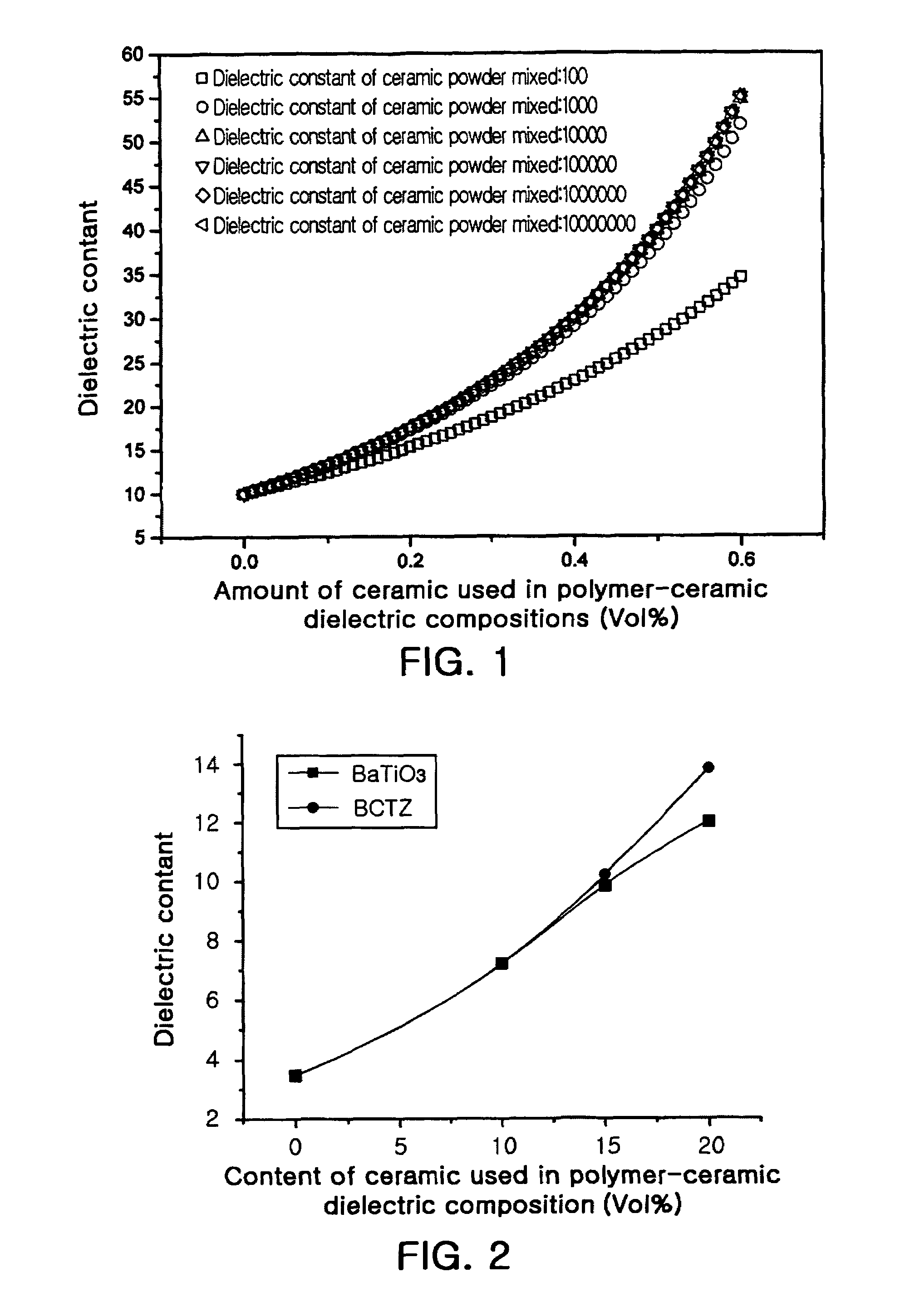Polymer-ceramic dielectric composition, embedded capacitor using the dielectric composition and printed circuit board having the capacitor embedded therein
a technology of polymer-ceramic dielectric composition and embedded capacitor, which is applied in the direction of fixed capacitors, fixed capacitor details, conductive pattern formation, etc., can solve the problems of limited processing characteristics of printed circuit boards, large obstacles to miniaturization of final products, and various kinds of passive elements mounted on printed circuit boards
- Summary
- Abstract
- Description
- Claims
- Application Information
AI Technical Summary
Benefits of technology
Problems solved by technology
Method used
Image
Examples
example 1
[0075]Ceramic powders were prepared in accordance with the compositions (Inventive Ceramics 1 to 6) indicated in Table 3. Each of the ceramic powders was ball-milled and mixed for 12 hours using ethanol as a solvent and zirconia balls. The mixture was dried at 200° C. for 12 hours, calcined and / or baked. The calcination was performed by heating the mixture at a rate of 5 ° C. / min., maintaining at the final temperature for 2 hours, and cooled. The thermally treated mixture was pulverized using ethanol as a solvent and zirconia balls for 24 hours, and dried at 200° C.
[0076]The dried ceramic powder was mixed with 20 vol % of a bisphenol A resin (epoxy type). Specifically, the mixing was carried out by mixing a bisphenol A resin, dicyanoguanidine as a curing agent and Re 610 as a dispersant together in acetone, and blending the mixture blended with the ceramic powder to prepare a slurry. At this time, the ratio of the bisphenol A resin and the curing agent was adjusted to 62:8.5 (w / w), ...
example 2
[0081]The procedure of Example 1 was repeated, except that CaO was further added to the ceramics, the calcined materials were pulverized so as to have an average particle diameter of about 1 μm, and the resulting powders were blended with 44 vol % of the resin.
[0082]
TABLE 4AmountAmountAmountCal-Dielec-LossofofOfciningtriccoeffi-NbOCaOBaTiO3temp.con-cientCeramic No.(mol %)(mol %)(mol %)(° C.)stant(Df)Conventional001001100220.05Ceramic 1Inventive22100110019.90.03Ceramic 7Inventive32100110043.70.09Ceramic 8Inventive42100110026.20.02Ceramic 9Inventive82100110026.10.02Ceramic 10
[0083]The results of Table 4 reveal that the addition of the Nb oxide and the Ca oxide caused a great increase in the dielectric constant of the dielectric compositions.
[0084]Although the present invention has been described herein with reference to the foregoing embodiments, these embodiments do not serve to limit the scope of the present invention. All modifications having substantially the same constitution and...
PUM
| Property | Measurement | Unit |
|---|---|---|
| frequency | aaaaa | aaaaa |
| dielectric constant | aaaaa | aaaaa |
| temperatures | aaaaa | aaaaa |
Abstract
Description
Claims
Application Information
 Login to View More
Login to View More - R&D
- Intellectual Property
- Life Sciences
- Materials
- Tech Scout
- Unparalleled Data Quality
- Higher Quality Content
- 60% Fewer Hallucinations
Browse by: Latest US Patents, China's latest patents, Technical Efficacy Thesaurus, Application Domain, Technology Topic, Popular Technical Reports.
© 2025 PatSnap. All rights reserved.Legal|Privacy policy|Modern Slavery Act Transparency Statement|Sitemap|About US| Contact US: help@patsnap.com



